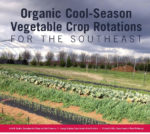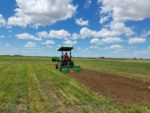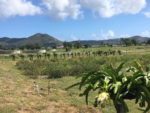Showing 381-390 of 420 results
 southern.sare.org news new-university-of-georgia-bulletin-focuses-on-cool-season-organic-vegetable-production
southern.sare.org news new-university-of-georgia-bulletin-focuses-on-cool-season-organic-vegetable-production New University of Georgia Bulletin Focuses on Cool-Season Organic Vegetable Production
ATHENS, Georgia – In the Southeast, where pests, diseases and weed pressures in the summer make organic vegetable production difficult, more efficient productivity and profitability may be found in shifting cash crop production to the fall. Cool-season vegetable production, combined with warm-season cover crop rotations for soil health, can set growers up for successful production […]
 www.sare.org news reflections-of-a-sare-fellow
www.sare.org news reflections-of-a-sare-fellow Reflections of a SARE Fellow
The 2014-2016 cadre of SARE Fellows visited numerous farms in Arkansas, Nebraska, Idaho, and West Virginia to study sustainable agricultural practices. The Fellows themselves were from Florida, Maine, Missouri, and Washington; they overlapped with eight other Fellows who were either starting or ending their two-year study period. The various locations visited, diverse enterprises studied, and range […]
 www.sare.org news sare-fellows-visit-oregon
www.sare.org news sare-fellows-visit-oregon SARE Fellows Visit Oregon
Every year since 2007, USDA’s Sustainable Agriculture Research and Extension program (SARE) and the National Association of County Agriculture Agents (NACAA) has offered a national Fellows program. The program is designed for Extension faculty who are interested in learning more about sustainable agriculture in different parts of the country. Eight Fellows, two from each of […]
 southern.sare.org news in-drought-stricken-texas-researchers-are-finding-water-conservation-solutions-in-cover-crops
southern.sare.org news in-drought-stricken-texas-researchers-are-finding-water-conservation-solutions-in-cover-crops In Drought-stricken Texas, Researchers are Finding Water Conservation Solutions in Cover Crops
LUBBOCK, Texas – In the Texas High Plains, a region where the water-depleting Ogallala Aquifer endangers productive agriculture, and hot, arid winds erode soils and rob them of nutrients, cover crops offer a useful option to livestock producers. In a two-year graduate student study at Texas Tech University, funded through the Southern Sustainable Agriculture Research […]
 western.sare.org news pueo-are-much-more-than-pest-management
western.sare.org news pueo-are-much-more-than-pest-management Pueo are Much More than Pest-Management
If you can encourage a threatened native species, help control non-native pests, benefit the state’s farmers and preserve a culturally important icon, you’ve hit an ecological grand slam. That’s exactly what the University of Hawaii’s Melissa Price is trying to do with the islands’ pueo owls. The striking, dark birds are a species of short-eared, […]
 southern.sare.org news agriculture-in-u-s-virgin-islands-challenging-but-prevailing-with-sustainable-agriculture-practices
southern.sare.org news agriculture-in-u-s-virgin-islands-challenging-but-prevailing-with-sustainable-agriculture-practices Agriculture in U.S. Virgin Islands Challenging, But Prevailing with Sustainable Agriculture Practices
CHRISTIANSTED, St. Croix – For months, a 14,000-gallon water tank has been sitting on its side in the middle of Frederick Miller’s Moringa tree orchard. Winds from Hurricane Maria had rolled the tank down the hillside of his farm, and he still hasn’t figured out yet how he’s going to move it. Yvette and Dale […]
 southern.sare.org news cover-crops-do-not-deplete-stored-water-in-the-soil-profile-clemson-researchers-find
southern.sare.org news cover-crops-do-not-deplete-stored-water-in-the-soil-profile-clemson-researchers-find Cover Crops Do Not Deplete Stored Water in the Soil Profile, Clemson Researchers Find
CLEMSON, South Carolina – Among the myriad of benefits cover crops provide to a row crop or vegetable operation, Clemson University researchers have found another one: Cover crops do not deplete water stored in the soil profile, thus preserving the precious resource for the cash crop – an all important function, specifically in times of […]
 southern.sare.org news cover-crops-have-benefits-in-high-tunnels
southern.sare.org news cover-crops-have-benefits-in-high-tunnels Cover Crops Have Benefits in High Tunnels
GLENWOOD, Georgia – Barley and hairy vetch growing vigorously in a high tunnel at Lola’s Organic Farm in southeast Georgia were going to seed. It was mid-April. Time to mow and prepare the soil for the summer’s cash crops: ginger and turmeric. Since last year, couple Jennifer Taylor and Ron Gilmore – USDA certified organic […]
 northcentral.sare.org news charles-francis-ncr-sare-hero
northcentral.sare.org news charles-francis-ncr-sare-hero Charles Francis: NCR-SARE Hero
Read more about Charles Francis.
 northcentral.sare.org news robert-wills-ncr-sare-hero
northcentral.sare.org news robert-wills-ncr-sare-hero Robert Wills: NCR-SARE Hero
Read more about Bob Wills.